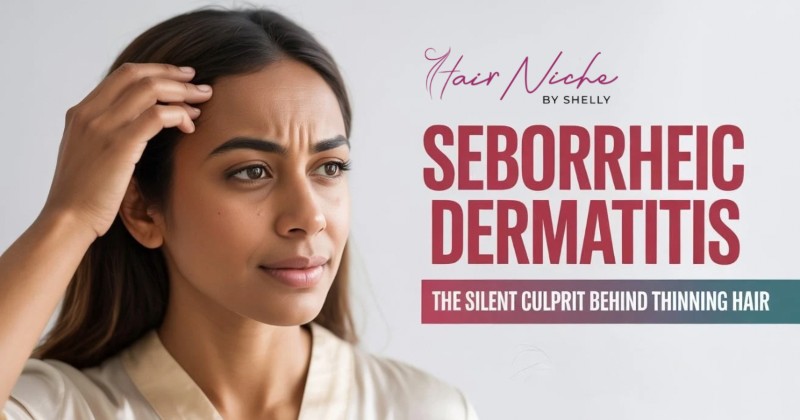
Seborrheic Dermatitis: The Silent Culprit Behind Thinning Hair
Hair loss isn’t always caused by stress, aging, or genetics. Sometimes, the culprit is hiding right on your scalp an itchy, flaky, and inflamed condition known as seborrheic dermatitis. Many people mistake it for ordinary dandruff, but when left untreated, it can weaken hair follicles and contribute to thinning hair over time.
At THE HAIR NICHE BY SHELLY, we understand that hair thinning isn’t just about looks it’s about confidence, identity, and overall well-being. That’s why we focus on 100% natural, customizable human hair toppers and wigs, allowing women to regain confidence while managing scalp health issues like seborrheic dermatitis.
What is Seborrheic Dermatitis?
Seborrheic dermatitis is a common inflammatory scalp condition causing redness, flakiness, and itching. It occurs when your scalp produces excess oil or reacts to a naturally occurring fungus. While it isn’t life-threatening, seborrheic dermatitis can damage hair follicles over time, making hair weak, brittle, and prone to shedding. Scratching the irritated scalp can worsen hair loss, creating a frustrating cycle.
How Seborrheic Dermatitis Leads to Hair Fall
- Inflammation: Irritated scalp tissue weakens hair follicles, reducing hair growth.
- Excess Oil & Flakes: Oil and dead skin cells clog follicles, slowing growth.
- Scratching: Continuous scratching damages hair, causing breakage and shedding.
Recognizing seborrheic dermatitis early is key. Persistent scalp redness, flakes, or increased hair shedding are signs that your scalp needs special care.
Managing Hair Loss While Keeping Your Style
The first step is medical treatment. Medicated shampoos, topical creams, and proper scalp hygiene can control inflammation and fungal growth. A healthy diet and stress reduction also improve scalp health from within.
While addressing the root cause, it’s natural to want confidence and style on the outside. That’s where THE HAIR NICHE BY SHELLY comes in. Their customizable hair toppers and hair wigs for women made from 100% natural human hair provide instant coverage for thinning areas. These toppers allow you to safely experiment with human hair volumizers and streak colour, so you can add dimension, thickness, and playful color to your hair without irritating the scalp. This way, you can maintain your fashionable look while giving your scalp the care it needs to heal
Why Confidence Matters
Hair is more than strands — it’s a reflection of self-esteem and individuality. Experiencing hair thinning due to seborrheic dermatitis can be discouraging. Using natural hair solutions from THE HAIR NICHE BY SHELLY allows you to maintain confidence while your scalp heals. You can enjoy volumized styles, streaks, and trendy looks, showing off your personality without compromising your hair’s health.
With the right combination of medical care, scalp-friendly routines, and professional hair solutions, you can manage seborrheic dermatitis effectively while keeping your hair looking full, stylish, and healthy.
Takeaway: Seborrheic dermatitis can silently contribute to hair thinning, but it doesn’t have to limit your style. By combining proper scalp care with high-quality, natural hair toppers from THE HAIR NICHE BY SHELLY, you can protect your hair, maintain confidence, and experiment with volumizers and streaks, letting your natural beauty shine.
FAQs:
Q1: Can seborrheic dermatitis really cause hair loss?
Yes. While not a direct cause of permanent baldness, seborrheic dermatitis leads to inflammation, itching, and excess oil which can weaken hair follicles and result in increased shedding or hair thinning over time.
Q2: What are the early signs of seborrheic dermatitis on the scalp?
Look for persistent redness, itching, flaking (similar to dandruff), and increased sensitivity on the scalp. These are early indicators that the scalp’s health is compromised.
Q3: Is seborrheic dermatitis the same as dandruff?
No. While both cause flaking, seborrheic dermatitis is an inflammatory condition that can be more severe, involving redness, irritation, and potential hair loss.
Q4: How can I treat seborrheic dermatitis?
Treatment usually involves medicated shampoos (e.g., with ketoconazole, selenium sulfide, or zinc pyrithione), topical antifungals, and improving scalp hygiene. Lifestyle changes like stress management and a healthy diet can also help.
Q5: Can I wear wigs or hair toppers if I have seborrheic dermatitis?
Absolutely. At THE HAIR NICHE BY SHELLY, our natural, breathable human hair toppers are designed to be scalp-friendly and customizable—ideal for women managing conditions like seborrheic dermatitis.
Q6: Will using a hair topper worsen my scalp condition?
No—if chosen correctly. Our toppers are made with natural materials and allow your scalp to breathe, minimizing irritation. Always follow proper scalp care while wearing them.



